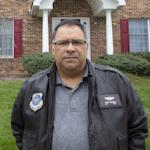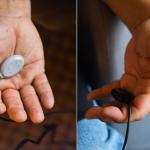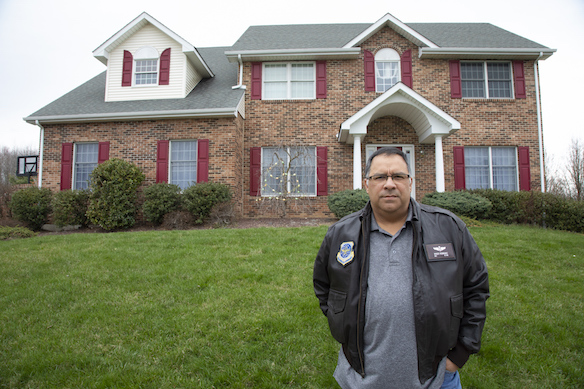Putting It into the Past
Veteran Rogelio “Roger” Rodriguez’s experience with EMDR

Maj Rogelio "Roger" Rodriguez Jr.
US Navy US Air Force, 1987-2013
“My traumatic thoughts don’t come to the forefront of my everyday life and consume my thoughts… they have been processed and placed into long-term memory where they belong.”
A month after the terrorist attacks of 9/11, Rogelio “Roger” Rodriguez was headed out for his first tour of the Middle East. He was young and enthusiastic, the life of the party, and a self-described adrenaline junkie. By 2009, he had completed 10 deployments for the Delaware Air National Guard. As a Senior Flight Nurse, Roger managed crews that cared for wounded soldiers as they were airlifted from war zones to the next level of care. Many were badly injured — mangled by IEDs, sniper fire, or active combat. Sometimes he helped ferry them to points nearby, sometimes to Germany, and on occasion it was all the way back to the United States. Roger estimates that by the time he retired in 2009, he had helped to evacuate more than 2,000 soldiers.
During his ninth deployment, Roger sensed a change in himself.

I started to not be scared, not have a little fear of flying into the combat zone. And that’s not healthy."
The tours had started to add up. Everything he had seen and done weighed heavily on him. His weekly phone calls home, once full of funny anecdotes, were becoming flatter. He was less engaged, more serious and distant. But he went back for one more deployment.
Roger returned from his tenth and last tour just before Thanksgiving 2009. “I knew that something was wrong. I couldn’t put my finger on it, but I knew something was wrong with me on the inside.”
Each tour took a little bit from me mentally, spiritually, and physically. I just was getting beat down. And when I came home, I'm broken. I felt like I had an electric charge running through my body all the time."
Roger Rodriguez
At home, Roger had largely retreated to his room, spending hours on his laptop or watching TV. He took a break from coaching his son’s soccer team, and didn’t always go to his daughter’s dance performances. He couldn’t seem to get back into his civilian life, as he had done after all his other tours.
Roger’s wife, Carina, worried that she’d lost the fun-loving family man she’d married. The children told her a number of times that they wanted their old dad back. But the tipping point came when Roger said he didn’t think he could go back to his civilian job. The family had counted on incomes from 2 working parents. They had plans to send their children to college, take family vacations, and save for retirement. When that appeared to be in jeopardy, Carina delivered an ultimatum: Get help, or risk losing your family.
Roger went to a nearby Vet Center. He met with a Readjustment Counselor who evaluated him and diagnosed him with PTSD. The counselor, who would become his PTSD therapist, offered him several effective treatments. Roger chose Eye Movement Desensitization and Reprocessing (EMDR).
I thought, I'm willing to try anything to feel better, so let's do it. It's work. You have to trust your therapist. You have to trust yourself to work through traumatic thoughts."
Roger Rodriguez
In EMDR, you work with your therapist to lower your stress as you bring the traumatic memory to mind. When you feel less stress, your mind can bring in new information, and you’ll start to experience the memory in a different way. The events don’t change, but the way you understand them will.
To do this, you start by choosing one part of the trauma to pay attention to. At the same time, your therapist asks you to focus on short sets of back-and-forth eye movements, taps, or tones. Your therapist will check in with you to find out whether there are any changes in the memory or how it makes you feel. You and your therapist then repeat the process until the memory doesn’t feel upsetting anymore. Over time, a new, more constructive view of the memory will take the place of the old one, and you will have fewer psychological and physical symptoms of PTSD.
As Roger explained, “It [the memory] will be re-filed.”
Roger’s therapist first tried a light bar. But he had a medical condition that affected his balance, making it hard to look at the moving lights.

I couldn’t handle the blinking lights back and forth.” Instead, his therapist suggested using vibrating hand tappers, which were much more comfortable for him. The next step would be to target the traumatic memory.
The first [traumatic event] that came to mind was being shot at for the first time. It was missile lock. I recall the event as it happened, but I'm watching it from a distance and just watching the event take place with me in it.”
Roger Rodriguez

“Therapy is work. For those people that don’t think therapy is work, it is work. You have to believe that what you’re doing is going to make yourself whole again.”
After each session, Roger would leave his therapist’s office feeling like “a little weight” had been lifted off of his shoulders. Each time, his stress level would lower, and stay lower for a longer period of time.
At home, his family was in full support. Though they mostly focused on their own busy schedules, Roger’s therapy appointments always came first. They each made sure to give him the time and space he needed to go to treatment and to get better.
I just feel more comfortable in my own skin where I did not before. The new me is more relaxed, more calm, open to listening to people and their views and where they are and not taking everything to heart as before."
Roger Rodriguez
Today Roger is back in the flow of family life: helping with homework, going to soccer games and dance practices, and joking around at raucous family dinners. And he’s found a job he loves, as a nurse in a school for chronically ill children. He says, “This job is a good fit, ” both for him and for his family.
His old friends from the Air National Guard called him often to tempt him back. They told him that when he gets bored and is ready for some high-altitude action, they’d put him back in the helicopter. “No, thank you,” he’d tell them. “I love you but I don’t think I want to do that anymore.”

Now and then they still check in.
“Are you bored yet?”
“Nope. I’m good!”

Want to learn more about EMDR?
Check out these videos featuring VA providers and Veterans who’ve been through it.